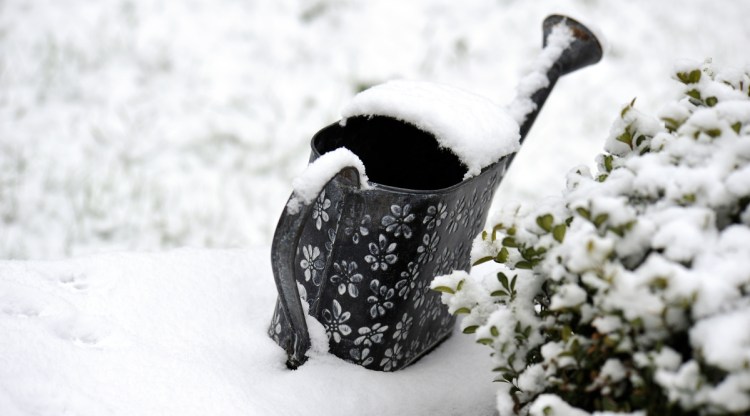When gardeners shivered in the below-zero temperatures that hit Maine in December and lasted through the first week of January, they received a benefit they probably were not thinking about at the time. Some, but not all, of the pests that damage plants were having problems, too.
It is not as simple as the cold weather freezing most pests to death.
Clay Kirby, who works in the Pest Management Office at the University of Maine in Orono, noted that many pests live in the duff (a layer made up of fallen leaves and twigs) on the top of the soil. A coworker of Kirby’s did a test as part of study on how ticks were faring, and found that the temperature in the duff, below the layer of snow, was 28 degrees even though the air temperature was well below zero.
“The snow can be considered insulation for them,” Kirby said, so ticks and other soil-living pests probably won’t suffer much.
A piece of good news for gardeners and tree lovers, though, is that winter moths – the caterpillar stage of which has decimated hardwood trees in several coastal communities – have had a bit of a setback.
Charlene Donahue, an entomologist with the Maine Forest Service, said there was a hatch of winter moths, which mate in late November and December, early in the season, so we should expect some caterpillars next spring. Winter moths mate when the flightless females climb trees and lure the flying males. The ones that got started early were successful.
But any late-hatching moths faced double trouble. First, extreme cold slowed them down, and that arrived in December.
“We also had a lot of snow, and then a rain and ice event,” Donahue said. “Winter moths go into cocoons all summer and fall, and when they come out, they can dig right through the snow, but the ice stops them.”
Gypsy moths can be sensitive to cold, so their population also could shrink.
For two other pests, the news is not as good. Or rather, score one for the pests; the news is not good for gardeners.
Like the winter moth, the browntail moth is so far affecting only communities along the coast. In its caterpillar stage, it not only eats the foliage from trees but, even worse, gives people a serious rash when they come in contact with the caterpillars’ poisonous hairs, which can separate from the caterpillar and fly through the air when the caterpillar molts.
Donahue thinks they’ll be, well, snug as a bug, despite the cold.
“You have to consider where they overwinter, which is at the end of branches wrapped in cocoons like silk,” she said. “And what do people wear when they want to stay warm in winter? Silk underwear.”
The silk should protect them from much harm.
The effect of the frigid temperatures on hemlock woolly adelgid is more complicated, however. This insect pest, which shows up as white splotches on the underside of hemlock needles, can kill the trees over time. It has shown up in southern and coastal Maine; a quarantine in all of York, Sagadahoc and Lincoln counties and parts of Cumberland, Androscoggin and Kennebec counties is intended to prevent the bug from spreading.
“They are cold sensitive, so the population will be reduced,” Donahue said. Unfortunately, the woolly adelgid is a champion reproducer, so it doesn’t take long for the population to rebound.
“Guess who survives? The ones that are cold hardy,” she said. In other words, as a result of natural selection the pests that survived, and the generations that descend from them, will be able to withstand future cold snaps better.
That developing cold tolerance coupled with the overall warming trend in the climate means that woolly adelgid could end up spreading more rapidly. It recently was discovered in the Sebago Lake region, Donahue said.
For plant diseases, the answer is simpler. The cold won’t bother them a bit.
“Basically, if the plant is still living, then the pathogen is still living,” said Alicyn Smart, who works at the Plant Diagnostic Lab at Orono. Under really harsh conditions the fungi that cause many plant diseases create sclerotia, a protective web that helps them survive.
And the diseases left behind in the soil, as with the ticks, will be protected by the snow cover.
With that, Smart sent me off on a tangent. “If the plant is still living …”
Gardeners, noting the warmer weather around the world as a result of climate change, have been experimenting with plants that require warmer temperatures.
In addition, the U.S. Department of Agriculture changed the Plant Hardiness Zone Maps in 2015, reflecting the warmer temperatures of recent decades. The zones do not reflect average temperatures, rather the coldest temperatures that occur during the winter. So if gardeners experimented with plants that reflected or exceeded the new zones in the last few gardening seasons, those plants may be in trouble.
Finding out how they handled the cold is another reason to look forward to spring.
TOM ATWELL is a freelance writer gardening in Cape Elizabeth. He can be contacted at 767-2297 or at: tomatwell@me.com.
Copy the Story LinkSend questions/comments to the editors.



Success. Please wait for the page to reload. If the page does not reload within 5 seconds, please refresh the page.
Enter your email and password to access comments.
Hi, to comment on stories you must . This profile is in addition to your subscription and website login.
Already have a commenting profile? .
Invalid username/password.
Please check your email to confirm and complete your registration.
Only subscribers are eligible to post comments. Please subscribe or login first for digital access. Here’s why.
Use the form below to reset your password. When you've submitted your account email, we will send an email with a reset code.